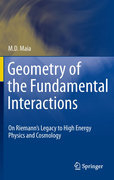
Geometry of the fundamental interactions: on Riemann's legacy to high energy physics and cosmology
Maia, M.D.
The Yang-Mills theory of gauge interactions is a prime example of interdisciplinary mathematics and advanced physics. Its historical development is a fascinating window into the ongoing struggle of mankind to understand nature. The discovery of gauge fields and their properties is the most formidable landmark of modern physics. The expression of the gauge field strength as the curvatureassociated to a given connection, places quantum field theory in the same geometrical footing as the gravitational field of general relativity which is naturally written in geometrical terms. The understanding of such geometrical property may help one day to write a unified field theory starting from symmetry principles. Of course, there are remarkable differences between the standard gauge fields and the gravitational field, which must be understood by mathematicians and physicists before attempting such unification. In particular, it is important to understand why gravitation is not a standard gauge field.This book presents an account of the geometrical properties of gauge field theory, while trying to keep the equilibrium between mathematics and physics. At the end we will introduce a similar approach to the gravitational field. Explains some of the most complex theories in physics in clear and understandable language Provides comprehensive information about three of the four fundamental forces of nature Offers an explanation of Yang-Mills theory, with many theoretical properties given in the form of examples INDICE: The Fundamental Interactions. The Physical Manifold. Symmetry. TheAlgebra of Observables. Geometry of Space-Times. Scalar Fields. Vector, Tensor, and Spinor Fields. Noether's Theorem. Bundles and Connections. Gauge Field Theory. Gravitation.
- ISBN: 978-1-4419-8272-8
- Editorial: Springer New York
- Encuadernacion: Cartoné
- Páginas: 171
- Fecha Publicación: 29/05/2011
- Nº Volúmenes: 1
- Idioma: Inglés
